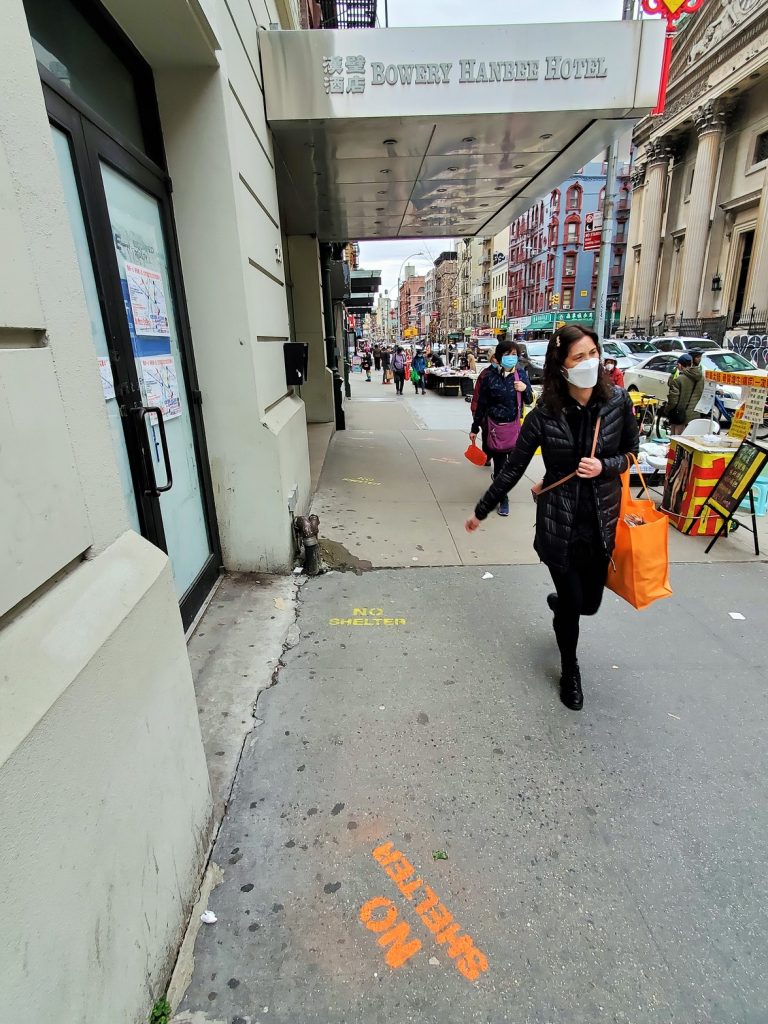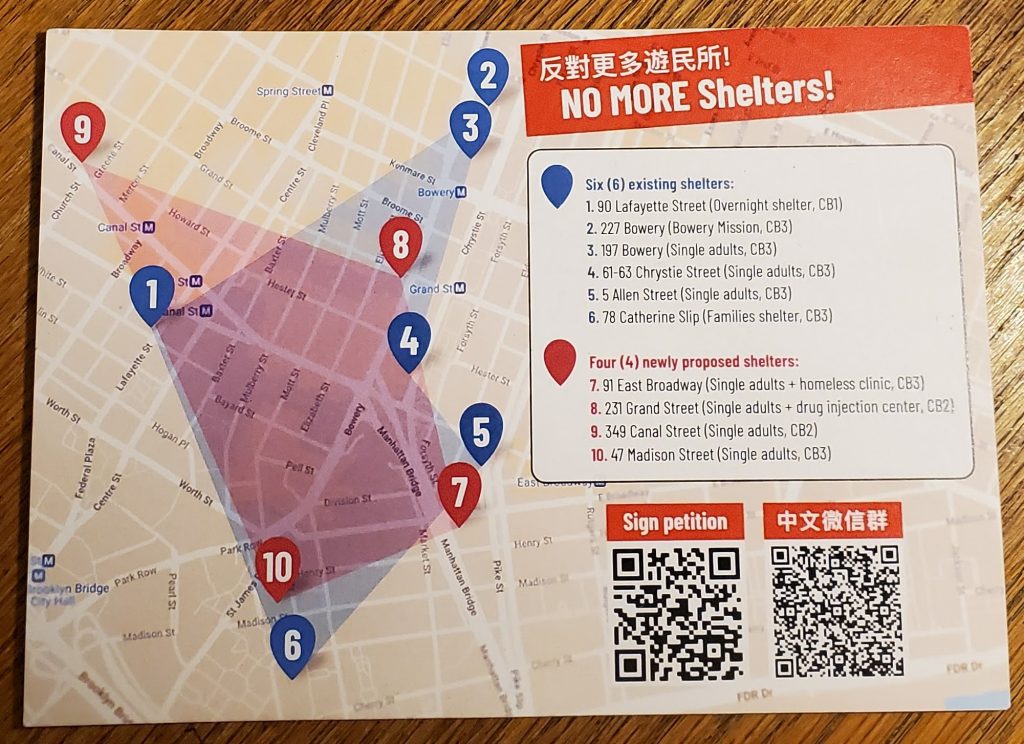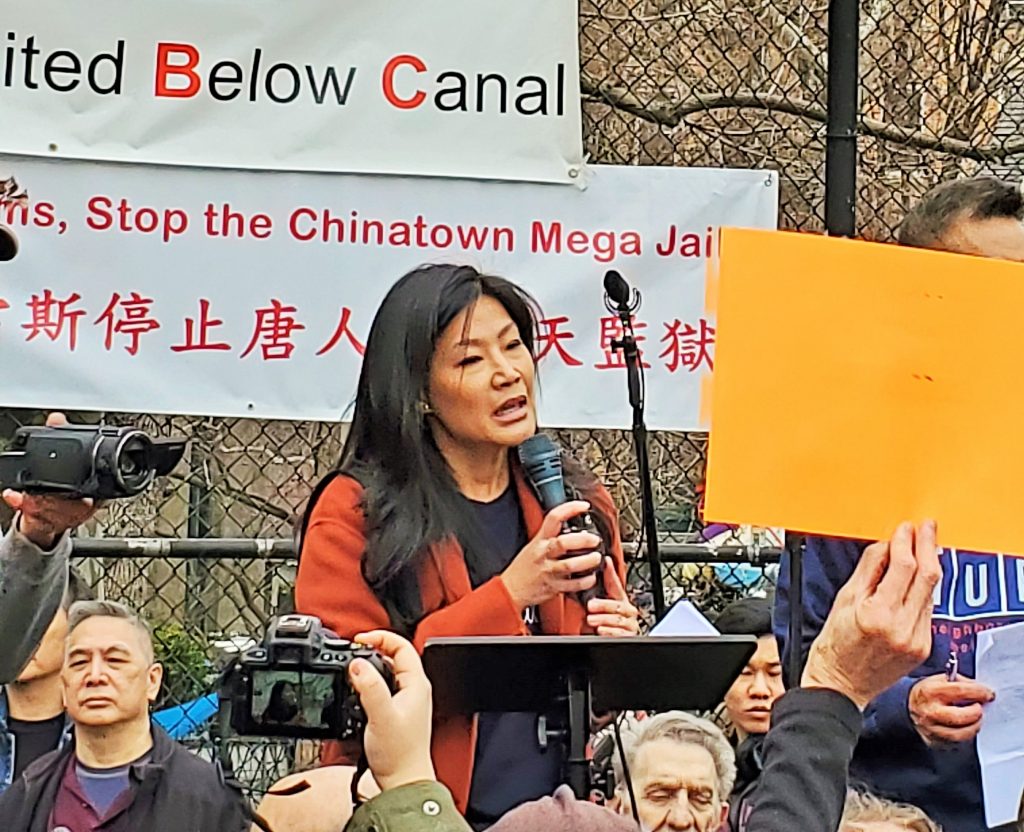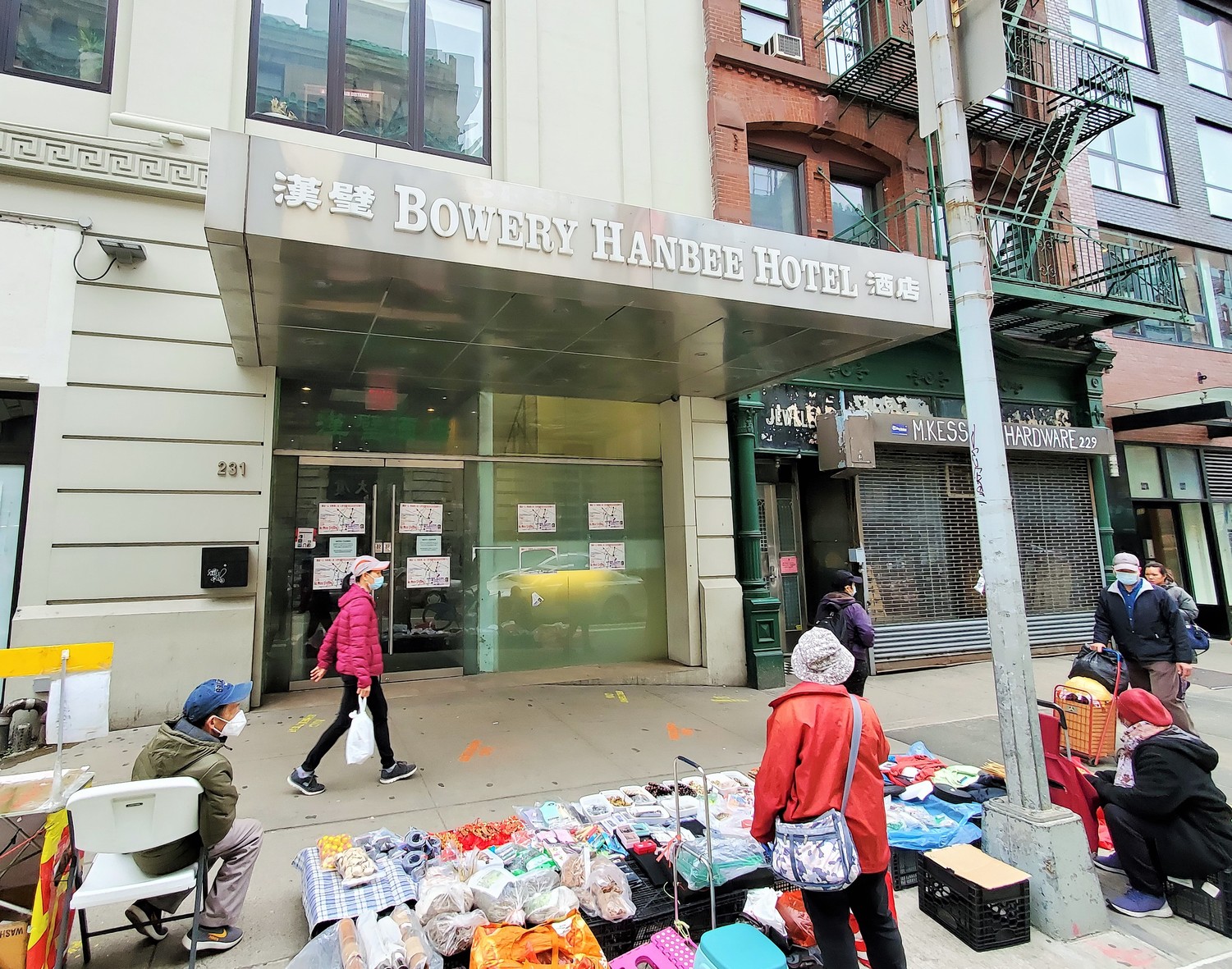BY LINCOLN ANDERSON | Updated Thurs., March 31, 2 a.m.: Nearly 500 people “packed” a Zoom meeting, albeit virtually, last Thursday evening as Chinatown residents turned out in force to oppose the city’s plan for a new Safe Haven-style homeless site in their neighborhood.
The homeless facility, planned at 231 Grand St., at Bowery, was the main attraction at the Community Board 2 monthly full-board meeting. Sixty-five members of the public testified, all but one of them — an Upper West Side woman — against the plan.
The board has also received 3,600 postcards in opposition to the homeless shelter plan.
Angry and concerned local residents and merchants charged that Chinatown, in the past few years, has become a “dumping ground” for homeless shelters, and that the area’s safety and quality of life, as a result, have plummeted. They said that flooding the neighborhood, which is “a community of color,” with homeless shelters is “pitting one marginalized community against another marginalized community.”
‘Please write a resolution’
During the meeting, many speakers pleaded for C.B. 2 to “write a resolution” about the planned homeless site. Usually community board resolutions take a position for or against an issue, though are only advisory.
“We live in constant fear,” Amy Wu told the board. “Many of us know people personally who have been assaulted. It’s been a terrible two years for us. Please represent us in opposing this shelter.”
Many of the anti-Asian attacks, she added, have been by mentally ill homeless individuals.
As of last week, though, the board had only written a letter to the city. The letter notes that there is strong opposition to the planned shelter in Chinatown, whose residents see it as an “additional blow” to the community, and also urges that a “fair share” analysis of homeless shelters should consider the number of sites clustered within the “radius” of Chinatown — not just how many sites are in each of the three separate community boards that include parts of Chinatown. Community Board 3, for example, has a number of homeless shelters but C.B. 2 currently has none.
“It’s a good letter, but I’m not sure why it took the form of a letter and not a resolution,” noted C.B. 2 member Frederica Sigel during the board members’ discussion at the end of Thursday’s meeting. “I feel irresponsible if the board doesn’t vote. I think we need to take a position on whether we approve this project or not.”
“I feel that the letter does not reflect the depth and scope and passion of the community’s opposition,” added Cormac Flynn.
“It’s our responsibility to reflect and advocate for the community and I’m not sure that the letter reflects that,” added Ritu Chattree, another board member. “Regardless of whether C.B. 2 has a voice in the process, I think we have a moral obligation to amplify the community’s voice on this.”

After a back-and-forth discussion at the end of the meeting, C.B. 2 members agreed that they would, in fact, write a resolution, with “an opportunity to vote” next month, on the planned Grand Street shelter.
Committee won’t oppose shelter
For her part, Susanna Aaron, the chairperson of the board’s Human Services Committee, which will draft the resolution, emphatically stated more than once during the meeting that she would not take a position against the homeless site.
“We’re not going to say that we’re opposed to that shelter,” she stressed of her committee, also saying, “I personally will not take a position in opposition to this shelter.”
Aaron also said that writing a resolution “doesn’t really matter” since the community board is not required to weigh in on the issue, adding that the board was already told by the city’s Department of Homeless Services that “this process is going forward.”
Sigel expressed concern that the board make its position known as soon as possible, and pushed to hold a vote on the shelter that night. But she relented after it was agreed that the board would draft a resolution. It wasn’t immediately clear when the city plans to award the contract to Housing Works, but it’s apparently imminent.
Jeannine Kiely, the C.B. 2 chairperson, did not initially respond to a request for comment from The Village Sun about why the board had not chosen to take a stance on the Grand Street facility up to that point and why it has generally refrained from weighing in on planned homeless shelters within its district. As was noted at the meeting, though, the city does not require an advisory opinion from local community boards for the siting of homeless shelters.
Basically, however, since C.B. 2 currently has no homeless shelters, board leadership apparently is reluctant for the board to go on record opposing the Grand Street facility. There is also concern about being NIMBY.
April vote on resolution
After this article’s publication, Kiely did send a response:
“Last week, C.B. 2 unanimously approved changes to our 231 Grand St. letter to include the significant opposition and grave concerns conveyed by our community throughout more than four hours of public testimony,” she said. “Attached to this letter is the 12-page Human Services Committee report.
“Because shelters are as of right, community boards have no role in approving them, therefore, C.B. 2 typically writes a report after the first committee meeting. We then invite city agencies and potential shelter operators to return to a future C.B. 2 meeting to address community concerns and issues.
“C.B. 2’s Human Services Committee will discuss the testimony C.B. 2 received at our March board meeting, as well as a resolution on the 231 Grand St. shelter during its business session on Thurs., March 31. The resolution will go to C.B. 2’s full board for a vote on Tues., April 26.”
Niou: It’s up to mayor
Similarly, Assemblymember Yuh-Line Niou said City Hall controls the process.
“It’s up to the mayor to stop it, so people should make their concerns known,” she said. As for her own position on the shelter, Niou said she supports “more transparency,” adding “a holistic approach and more housing” are needed.
The assemblymember said she would write a letter to the mayor encouraging him to talk to the community about the situation.
However, C.B. 2 previously did recommend approval of a planned women’s shelter in Greenwich Village on W. 11th Street, though later steered away from weighing in on a planned, large, congregate-style men’s homeless shelter at Canal and Wooster Streets in Soho, as well as on Paul’s Place — which will be a Safe Haven-style site, like 231 Grand St. — at W. 14th Street, between Sixth and Seventh Avenues, which is slated to open soon.
The board did not opine on either Paul’s Place and the 200-person Soho shelter reportedly due to strong community concerns about the projects. As it turns out, though, the W. 11th Street women’s shelter project is tied up in litigation by residential neighbors who are fighting it.
C.B. 2 trying to ‘do its share’
Prior to all of these new planned sites, C.B. 2 did not have any homeless shelters in its district, which is bounded by W. 14th Street, the Bowery / Fourth Avenue, Canal Street and the Hudson River. As a result, the community board feels an obligation for the district to “do its share.”
Chinatown, though, already feels it is doing more than enough.
The opponents cry that Chinatown is oversaturated with homeless shelters, with six current ones, and four more on the way. However, the C.B. 2 Human Services Committee is reportedly currently doing its own due diligence to confirm that the addresses that the opponents cite are, in fact, all homeless shelters. In addition, the opponents cite the planned 200-man shelter at 349 Canal St. as being in Chinatown, though most people would say this is Soho, although admittedly near to Chinatown.
Highlighting the terrifying rampage of anti-Asian violence, opponents noted that Christina Yuna Lee, 35, was brutally killed by a homeless man in her own apartment on Chrystie Street in February, just a block and a half away from the planned Grand Street homeless site.

Moms and kids’ safety signals
At Thursday’s meeting, a couple of Chinatown moms testified about using special hand signals and “code words” with their young children as a warning when an unhinged-looking homeless person is nearby.
“We’ve been lunged at,” one of them said. “We’ve witnessed drug deals in Sara D. Roosevelt Park, seen them shoot up.
“Christina Lee’s murderer and I have crossed paths numerous times when we walked the streets,” the woman said, adding she “was not surprised” that the man ultimately killed someone.
“We don’t need Housing Works to import and increase the population” of mentally ill and drug-using individuals from other areas, “like Washington Square Park and the subway,” she said.
For the record, the C.B. 2 Human Services Committee is also currently researching whether Lee’s alleged killer, Assamad Nash, who recently was indicted for her murder, was living at the Bowery Mission’s shelter at the time, as the media has reported, or was, in fact, living on the street.
Kids can’t use S.D.R. Park
Several parents from the Swan School, a dual-language Mandarin/English school at 90 Bowery, lamented that, due to a couple of violent incidents on the street, the school no longer feels it’s safe to take the kids to S.D.R. Park to play outdoors. A young student from the Transfiguration School, at 29 Mott St., spoke about “a strange man” coming into the school’s courtyard and loudly banging around as a teacher sheltered the kids inside the building.
“Our friends and family need safety,” the student said. “Chinatown is our home. I’m not against helping members of our community, but this is about giving us basic safety. We have to stop the Asian hate. These shelters aren’t going to help.”
Another young student, though, did not show empathy when he testified that the local subway station was “infested with homeless.”
One local mother expressed outrage that Level I and II sex offenders would be permitted at the Grand Street shelter site. She noted she looked up what’s covered under Level II and found that it includes sex trafficking, “transportation to engage in criminal activity” and pushing pornography.
“This is a recipe for disaster,” she seethed.
Former judge: Enough
Doris Ling-Cohan, a recently retired New York State Supreme Court justice, also testified against the plan, noting the neighborhood already has six homeless shelters.
“Enough,” she declared. “This is an affront to our community. There’s not an Asian American who has not been harassed or assaulted or knows someone who has been.”
Ling-Cohan said locals should not be forced to “take a leap of faith” and believe that adding a harm-reduction homeless shelter would actually help the community.

The level of fear gripping the city’s Asian population is extreme, speaker after speaker said.
“If the shelters made us safer, wouldn’t we already be safe?” Thomas Leung asked. “Everyone is in fear. People walk in groups to the subway.”
Young mom: This is dumping
Jennie Ma, a young mother who lives right next to the Grand Street site, said, “I’m frankly terrified of this shelter opening up. What they’re really doing is congregating all the homeless people that are around into the heart of Chinatown. This is dumping — this was a thriving hotel.”
Under the city’s plan, Housing Works would acquire the currently vacant Bowery Hanbee Hotel, at 231 Grand St., an eight-story building at the southwest corner of Grand Street and Bowery.
Over the past summer the location was used as a “COVID hotel” as the city temporarily moved people out of its congregate homeless shelters. Locals said this caused conditions on Grand Street to worsen noticeably. A bank ATM next door has become unusable and local bakeries are staked out by aggressive panhandlers, they said.
The Housing Works plan calls for a 24/7, co-ed facility that would include a drop-in center for up to 50 persons, plus 94 stabilization beds in individual rooms. Couples would be allowed to share a room. The goal would be for individuals in the stabilization beds to be placed in permanent housing within 12 months.
Since the building is already configured as a hotel, and doesn’t need any major renovations, it could be up and running as soon as May. It’s an “as of right” facility, meaning there is no ULURP land-use review process required for the city to site it there.
Harm-reduction model
The Safe Haven site, according to Housing Works C.E.O. Charles King, would follow the harm-reduction model, and so would have “a very, very low threshold” for entry. People would not be searched for drugs or alcohol — nor for weapons. They would be allowed to shoot up drugs and nod out in the comfort of the facility, which King argues is better — both for the substance abusers themselves and the surrounding community — than their doing so on the street or in Sara D. Roosevelt Park.
Speaking at last week’s meeting, King reiterated that the city has identified 150 unsheltered homeless in the surrounding area.
“These are the folk we intend to bring into the drop-in shelter,” he said, “and get them permanently off the streets.”
King said Housing Works has used the harm-reduction model for the past 30 years and that it has proven to be effective because “it moves drug use off the streets. We believe people will come to see this as a vital facility,” he said.
Locals, though, were skeptical that drug users would remain inside the facility after injecting, but would want to go outside and hang out, especially in warm weather.
Mayor touts Safe Haven sites
In conjunction with the mayor’s new vow to sweep out homeless encampments around the city, Adams has praised the Safe Haven sites as offering a healthier and safer alternative than living on the streets — or in a tree, as one homeless man was recently doing in Riverbank State Park in Harlem. Hundreds of Safe Haven beds will be coming online in the Bronx, he said. This particular Safe Haven site at 231 Grand St. was put in the pipeline under former Mayor de Blasio.
However, some speakers at last week’s meeting said that a better way to use 231 Grand St. to help the community is not as a Safe Haven homeless shelter but as what it previously was, a commercial hotel, which would help boost the area’s economy. It was formerly a Best Western.
“This street is a main street of our community,” Pastor Austin Wu, a Chinatown native, stressed. “Chinatown needs this facility to be what it was before COVID — it drew tourists and provided places for family visitors. Chinatown needs this hotel to be a hotel — not a shelter.”


Thank you for pointing out the hypocrisy of those who say they can’t take a position, but have previously taken a position.
Less than a half mile away from 231 Grand St. is a new harm reduction center at 35 East Broadway (Alliance LES Harm Reduction Center),
Visitors can:
-Exchange syringes in complete anonymity
– Get sterile injecting equipment and safer sex supplies
– Receive Narcan/Naloxone overdose prevention meds and learn essential practices and procedures.
– Be tested for HIV or hepatitis C (Rapid testing)
-Get medical and mental health care, counseling, and referrals
-Sign up for case management
Housing Works will not be doing anything different other than using outreach to bring more mentally ill or addicts into a densely populated location. They will not be serving the Chinatown community. The shelter at 61-63 Chrystie St is an existing one across from Sarah D Roosevelt Park, where they already don’t search for weapons or drugs and have vacancies. Charles King said that the population of homeless being served in Chinatown are located in Sarah D Roosevelt. Work with the existing shelters don’t add a 7th shelter when there’s already 227 Bowery, 197 Bowery and 61-63 Chrystie all within 1,000 feet of each other or less.
Consideration for shelters should be radius and distance from the others since the shelters are placed literally on the dividing lines of CB2 and CB3.